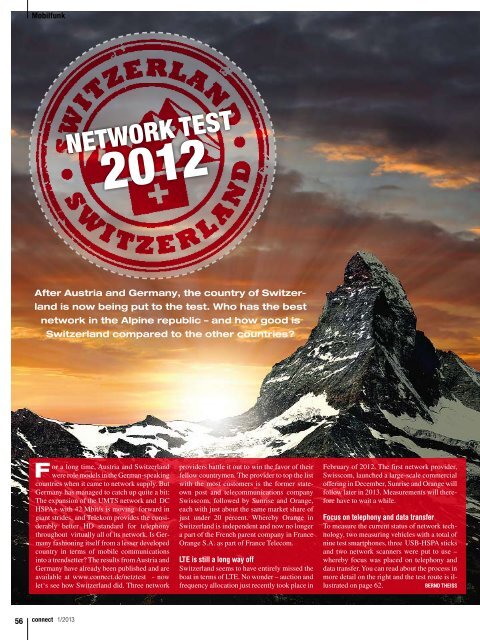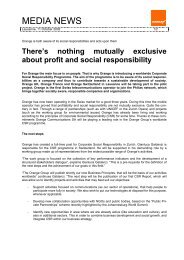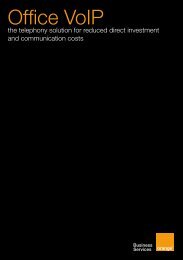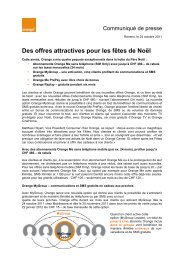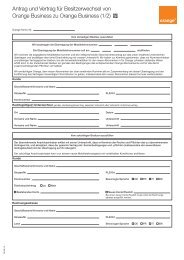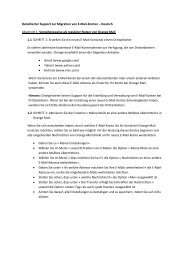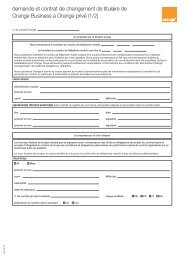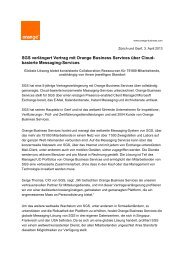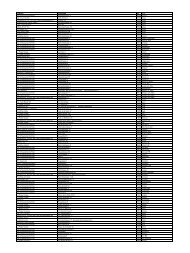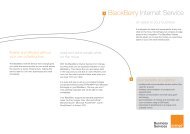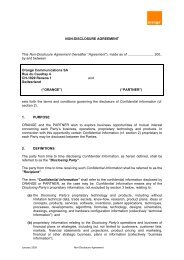'connect' magazine (PDF) - Orange
'connect' magazine (PDF) - Orange
'connect' magazine (PDF) - Orange
- No tags were found...
You also want an ePaper? Increase the reach of your titles
YUMPU automatically turns print PDFs into web optimized ePapers that Google loves.
MobilfunkNetwork Test2012After Austria and Germany, the country of Switzerlandis now being put to the test. Who has the bestnetwork in the Alpine republic – and how good isSwitzerland compared to the other countries?For a long time, Austria and Switzerlandwere role models in the German-speakingcountries when it came to network supply. ButGermany has managed to catch up quite a bit:The expansion of the UMTS network and DCHSPA+ with 42 Mbit/s is moving forward ingiant strides, and Telekom provides the considerablybetter HD standard for telephonythroughout virtually all of its network. Is Germanyfashioning itself from a lesser developedcountry in terms of mobile communicationsinto a trendsetter? The results from Austria andGermany have already been published and areavailable at www.connect.de/netztest - nowlet‘s see how Switzerland did. Three networkproviders battle it out to win the favor of theirfellow countrymen. The provider to top the listwith the most customers is the former stateownpost and telecommunications companySwisscom, followed by Sunrise and <strong>Orange</strong>,each with just about the same market share ofjust under 20 percent. Whereby <strong>Orange</strong> inSwitzerland is independent and now no longera part of the French parent company in France<strong>Orange</strong> S.A. as part of France Telecom.LTE is still a long way offSwitzerland seems to have entirely missed theboat in terms of LTE. No wonder – auction andfrequency allocation just recently took place inFebruary of 2012. The first network provider,Swisscom, launched a large-scale commercialoffering in December, Sunrise and <strong>Orange</strong> willfollow later in 2013. Measurements will thereforehave to wait a while.Focus on telephony and data transferTo measure the current status of network technology,two measuring vehicles with a total ofnine test smartphones, three USB-HSPA sticksand two network scanners were put to use –whereby focus was placed on telephony anddata transfer. You can read about the process inmore detail on the right and the test route is illustratedon page 62. Bernd Theiss56connect 1/2013
Last year, Swiss network providers truly shone in terms of reliability of mobile phone calls. Canthey surpass their own results on this year’s more difficult test route?TelephonyWith success ratios between nearly98 and some 99 percent in urbanareas, Swiss network operators haveshown us what is technicallypossible. Yet, the demands are onceagain much greater in 2012. Besidesthe well-supplied metropolisesof Zurich, Geneva, Basel and Bern,this year‘s test route also includedconsiderably smaller cities withless than 50,000 residents, wherebySchaffhausen and Biel representedthe smallest cities on the route(see page 62). This year, the measurementswere fully set on HDVoice, voice transfer with an extendedfrequency range and optimizedTelefonycompression algorithms, allowinga more natural sounding voicetransmission. Data transfers (Multi-RAB),much larger than in 2011,running parallel to the phone callalso made the voice test more difficult.In order for the test to rate aphone call as successful means thatthe call had to be established within15 seconds and stay stable untilthe end of the call after 75 seconds.During this period a total often voice samples are transferredand rated in line with the very latestpsycho-acoustic insights based onthe POLQA algorithm.Calling in the cities<strong>Orange</strong> had no problemsProviderSwisscom<strong>Orange</strong> SunriseTelephony (cities and surroundings)Success ratio/call establishment time (%/s) 98 / 5,3 98,4 / 4,3 96,5 / 5,2Voice quality/10% poorer than (MOS-LQO/MOS-LQO) 3,1 / 2,7 3,1 / 2,7 2,8 / 2,5Telephony (highways)Success ratio/call establishment time (%/s) 94,7 / 5,6 93,1 / 5 92,6 / 6Voice quality/10% poorer than (MOS-LQO/MOS-LQO) 3,1 / 2,6 3,1 / 2,6 2,8 / 2,4whatsoever in meeting these requirements.Connections were establishedafter an average of 4.3 secondsand remained stable until theend of the cycle 98.4 percent of thetime. The average voice qualitywas a MOS-LQO value (MeanOpinion Score Listening QualityObjective) of 3.1; which on averagecorresponds to a proper qualityvoice transfer with a good soundtendency. 10 percent of the voicesamples were below 2.7, whichmeans that the person at the otherend of the line could generally onlybe understood with great difficulty.In terms of absolute figures, Swisscomscored at the same level, whorecorded just 0.4 percent more errorsand needed an average of onesecond longer to establish a connectionwhen making a call. <strong>Orange</strong>as well as Swisscom can becompared to the German Telekomin terms of quality. This howevercan also be attributed to the factthat these network providers haverolled out their superior HD Voiceoffering. Sunrise, with an error ratioof 3.5 percent and a voice qualitythat frequently makes the listenerreally try their best to understand,scored less favorably in thisdiscipline.Calling on the highwayNaturally, the gap widens evenfurther when it comes to makingcalls on the highway. Swisscomprovides a satisfying call experiencewith nearly 5 percent faultycalls, the voice quality almostreaches city levels. <strong>Orange</strong> also offersgood voice quality onSwitzerland‘s highways, the successratio however plummets to93.1 percent.Noteworthy: During some of thecalls, the testers recorded longerperiods of audio failure, afterwhich the connection was re-established.Sunrise concluded the testwith a slightly higher error ratiothan <strong>Orange</strong>.This is how connect testsFotos: © astudio / Vaclav Volrab – shutterstock.de / © Peter Fenyvesi (5)P3 communications, the connect measuringpartner sent two test vehicles to take to theroad. One vehicle uses three HTC SensationXE devices to separately measure telephoneand data services. The advantage of thissmartphone model is that it supports HD Voiceand can thus record the superior audio benefitsof state-of-the-art mobile networks. The latestevaluation algorithm wideband POLQA isused to assess voice quality. During the telephonymeasurements, 100 kilobyte e-mailtransfers were run on the smartphones. TheMulti-RAB operation (Multi Radio AccessBearer) takes into consideration that data isfrequently transferred the same time a call isbeing made. Three further HTC Sensation XEphones in test vehicle 1 were adapted in termsof software so data transfers could be measuredautomatically. The preinstalled browserautomatically loaded four very frequentlyused websites one after the other: GoogleNews, Wikipedia, Leo and ETSI. The mobilephone‘s operating system automatically triggeredfile uploads and downloads, the installedvideo player was used for the Youtubetest in standard resolution. Each measuringsmartphone was controlled by a fully equippedindustrial PC. In addition, each smartphonewas connected to an external antenna via a12-dB attenuator which was kept in a roofbox. The reason: In this manner, the telephonesmeasures typical levels ranging betweenindoor, car and outdoor conditions. An enhancedon-board power supply system with a secondgenerators and battery provided the uninterruptedpower supply.The second test vehicle was equipped similarly.During telephony measurements howeverno parallel multi-RAB data transfers wereperformed. Instead of smartphones that arerestricted in terms of speed, the best datasticksfrom the offering of the respective networkoperator were used. They were run on the industrialPCs with Windows 7 and the dashboardsoftware of the network operator. Thisshould provide measurement values as theywould ideally be on a well equipped notebookin the provider‘s network. As much more isrequired from notebooks in terms of data connectionsthan is the case with a smartphone,vehicle 2 also rendered HD Youtube videos inaddition to the standard resolution.On the highways, the network operatorscould show which data rates they could providefor classic uploads and downloads. To preventcostly downtimes during the measurements,spare smartphones, datasticks and controlunits were also on board.Controlled wireless communicationThe measurement vehicles areequipped with boxes androof antennas.57
MobilfunkEvery network provider should be able to provide quick Internet websites, e-mails and files.But do all providers actually meet this demand?Data via smartphoneOne HTC Sensation XE was usedper network operator to measuresmartphone data transfer rates. Witha gross transmission rate of 14.4Mbit/s for downloads and 5.76Mbit/s for uploads, higher loadsare only achieved by notebooksequipped with datasticks (see page60). Yet when surfing the Internet,uploading and downloading dataand viewing standard resolutionYoutube videos, even the measurementphones had to share radio resourceswith the population at large.Here the large network operatorSwisscom, with a market share ofmore than 60 percent, is faced withthe very special challenge of havingto secure capacities in an everDatA VIA Smartphonedenser and intensively utilized network– after all, all users of one cellhave to share its limited resources.Provider Swisscom <strong>Orange</strong> SunriseData smartphone (cities & surroundings)Internet website loadingSuccess ratio (%) 99,2 98,4 96,6Session time website 1-4 (s) 39,2 41,6 49,6File downloadSuccess ratio (%) 100,0 99,7 98,7Average session duration (3 MB)/data rate (TE*) kbit/s)(s/15,4 / 1614 14,1 / 1788 19,4 / 128890% faster than (kbit/s) 868 1092 708File uploadSuccess ratio (%) 99,7 99,0 98,7Average session duration (1 MB)/data rate (TE*) kbit/s)(s/8,3 / 1005 11,7 / 714 14,7 / 56590% faster than (kbit/s) 633 280 324YouTube (SD)Success ratio (%) 94,1 96,4 87,9Uninterrupted participation/start time (%/s) 93,3 / 6,3 96 / 6,1 86,4 / 8,2Data smartphone (highways)Internet website loadingSuccess ratio (%) 97,1 94,6 86,6Session time website 1-4 (s) 41,7 41,6 54,0File downloadSuccess ratio (%) 99,6 97,3 95,8Average session duration (3 MB)/data rate (TE*) kbit/s)(s/19,7 / 1260 14,8 / 1701 24,2 / 103690% faster than (kbit/s) 653 979 536File uploadSuccess ratio (%) 99,6 96,9 96,1Average session duration (1 MB)/data rate (TE*) kbit/s)(s/11,9 / 701 12,2 / 683 20,5 / 40490% faster than (kbit/s) 647 265 161YouTube (SD)Success ratio (%) 92,5 89,6 82,7Transfer rates in citiesThis exercise, which involved callingup typical popular websites,was best performed Swisscom inthe Browsing Session test. The accumulatedtime needed to loadwebsites was 39.2 seconds and inless than onepercent of the time didsomething go wrong. <strong>Orange</strong> finishedwith a 98.4 success ratio andneeded a whole two and a half secondslonger to load all four websites.Sunrise took 25 percent, orten seconds more, yet the error ratiothat rose to 3.4 percent is certainlymore cause for concern.While surfing the Internet, one canquick tell if something is taking toolong – a quick press of the reloadbutton is the natural response. Yetwhen downloading files by smartphone,things are not quite as clearand the premature reload processmay take just as much time as waitingfor the last bytes to mosey onin. It‘s a good thing thatSwitzerland‘s network operatorshave full command of this exercisewith success ratios ranging between98.7 percent (Sunrise) and100 percent (Swisscom).The speeds measured were all withinan acceptable range, whereby<strong>Orange</strong> leads with their averagedata rate and concluded 90 percentof the measurement with more than1 Mbit/s. During uploads,Swisscom‘s high reliability onceagain perseveres, and in terms ofspeed the Swiss market leader alsoleads the pack. Sunrise closelyfollows <strong>Orange</strong> for uploads, butboth are leagues behindSwitzerland‘s number 1 in terms ofspeed. <strong>Orange</strong> outperformed all inrendering films: This providershows Swisscom and to an evengreater extent Sunrise how to do it:with the highest share of uninterruptedviewing and the shortestdelays until actual viewing commences.Smartphones on highwaysNaturally, measurements on highwaysare much more demanding.This fact however is not reallychallenged by Swisscom with asuccess ratio of 97.1 percent whendownloading websites, <strong>Orange</strong> alsomanages a respectable 94.6 percent.What is even more astoundingis that with a download speed ofnearly 42 seconds for the four websiteson highways, it is hardly anyslower than in the city. Sunrise onthe other hand, topped the error ratiosand loading timewith a further ten percent, this confirmingonce again their third placeposition. The same applies to filedownload speed, during which<strong>Orange</strong> scored with higher speedsand battled it out neck-and-neckwith Swisscom in terms of reliability.Swisscom was way ahead inthe file upload test and Sunrisetrailed somewhat behind <strong>Orange</strong>.The same pattern was seen withYoutube on highways – which ensurethat Swisscom also won thesmartphone data measurements.58connect 1/2013


